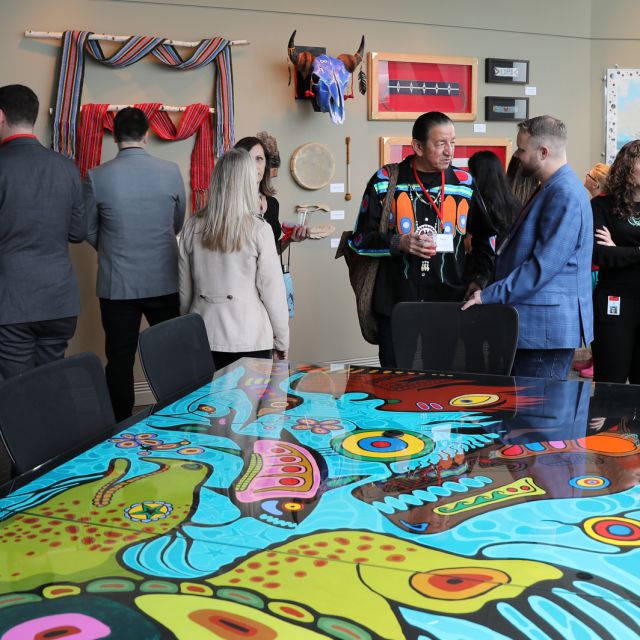Three Indigenous-led organizations share ideas for working closely with First Nations, Inuit and Métis elders, leaders, artisans and experts.

Building strong relationships with Indigenous communities—whether you’re planning a business event or other professional pursuit—isn’t about ticking a box or meeting minimum requirements, but rather creating meaningful work where there’s an opportunity for capacity building, says Crystal Martin, an Inuk speaker and activist.
Here, three Indigenous organizations share ideas on how to include First Nations, Inuit and Métis expertise at your business events in Tkaronto a.k.a. Toronto.
1. Listen to and learn from Indigenous communities
When working with Indigenous partners, it’s important, first and foremost, that non-Indigenous people really listen.
Planners should be thinking beyond the land acknowledgement and/or asking Indigenous communities to help enhance their conference without giving anything in return. Establishing long-term relationships with Indigenous communities and really listening to them will have the most meaningful impact.
“You have to really listen and be flexible.”
– Matt LeMay, award-winning Métis filmmaker
“Métis, Inuit and First Nations are all very distinctive people with our own languages, cultures and traditions. A pan-Indigeneity approach doesn't work,” says Martin, who founded the production company Indigenous Geographic in 2022 with Matt LeMay, an award-winning Métis filmmaker. Together, they amplify the seldom told stories of the Métis and Inuit peoples.
In addition to producing documentaries and feature films, LeMay and Martin work with clients to provide Indigenous cultural awareness training, as well as event planning and program development services. Indigenous Geographic’s Mamawii program provides Indigenous cultural awareness training.
“Education needs to happen with a lot of the corporate entities we work with, especially understanding protocols when you’re working with Indigenous elders. It means you have to really listen and be flexible,” LeMay says.
Martin was involved in Pope Francis’ visit to Canada in 2022 to address the impact of colonization and the participation of the Catholic Church in the operation of residential schools.
“It's all about meeting the client where their needs are at,” says Martin. “We provided significant awareness training to the Church in order for them to understand the resources that are available in the North; and the languages and dialects heard during translation and interpretation during the visit.”
2. Create safe spaces where people can learn and talk about the impacts of residential schools
“We work with lots of corporate partners through our Legacy Spaces program,” says Sarah Midanik, CEO and President of The Gord Downie & Chanie Wenjack Fund (DWF), a national charity building a path towards reconciliation between Indigenous and non-Indigenous Canadians.
The Legacy Spaces program empowers organizations to create safe and welcoming places where people can learn and talk about the lasting impacts of residential schools. There are Legacy Spaces in offices and venues across Canada, including Steam Whistle Brewing, a brewery and event space in downtown Toronto.
For example, one of Canada’s Big Five banks, Scotiabank, has four Legacy Spaces, including two that are open to the public—at the bank’s 392 Bay Street branch in Toronto, and in Yellowknife, Northwest Territories. Midanik says DWF also partners with business and sporting events, which helps the organization reach new audiences. Scotiabank’s 392 Bay Street branch is an opportunity for visiting delegates to experience a Legacy Space, which illustrates how Toronto organizations are taking action on truth and reconciliation.
Event planners may also wish to invite a DWF representative to deliver a keynote at their conference or consider DWF as their event’s charity of choice, donating a portion of registration fees to the organization. Alternatively, they can raise funds through a raffle or auction—with Indigenous-made artwork, of course—or via a QR code that allows delegates to donate directly to DWF.
3. Make meaningful connections with Indigenous facilitators, trainers and conference speakers
Waaban Nang Collective, a 100 per cent Indigenous-owned and -operated company led by CEO Ginger Cote helps to foster respectful relations between non-Indigenous folks and a network of Indigenous content creators, facilitators, trainers, conference speakers and performers.
“Pre-work is really meaningful and sets the stage for everyone to come to the space with really open minds and open hearts.”
– Ginger Cote, CEO, Waaban Nang Collective
Cote says it's helpful when those seeking Indigenous partnerships have already researched the territory where the event is being hosted, have put thought into crafting a meaningful land acknowledgement and understand protocols like giving gifts of thanks and appreciation, such as a tobacco offering, to Indigenous speakers and facilitators.
“That pre-work is really meaningful and sets the stage for everyone to come to the space with really open minds and open hearts,” Cote says.
Waaban Nang Collective also helps negotiate contracts and fair fees, plus provides administrative assistance, such as ensuring payments are made on time. “Many are artists and contract workers,” Cote explains. “We make it a very easy and simple process for them when working with large organizations and companies.”
Story created in by Ignite Magazine



